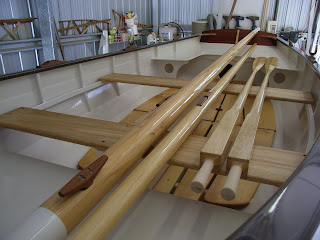Getting a Consistent Taper when Shaping Spars
Mike has attached a comment to my last posting, which I will answer very briefly. He is Mikes comment: -Thanks for sharing these insights into boat building Ross.
Something Im having trouble with is getting a consistent taper on a small diameter spar perhaps you could share some gems with us.
Cheers
Mike Now, I could write a very long answer to this, as it goes right back to the marking and cutting process if making a hollow spar, or to the lamination and marking process if building a solid stick. That is something for a proper book, so for the moment, Ill give just a quick run-down on my normal method - this applies to all sorts of spars, and to oars and paddles.
 |
| Here is a hollow mast glued-up. Despite the apparent disarray, the mast has been very carefully straightened and chocked on the bench so that the blank will be straight when the glue cures |
 |
| Rough planing of the mast is done with the longest plane I have on hand. This one is a Record No.5 Jack Plane - If I had a longer one Id use it. It is important to support the spar well, and to use little pressure, otherwise the spar will bow while the plane passes. |
 |
| Marking a square-sectioned, tapered blank for 8-siding using a home-made spar guage (the previous photos were of a Birds Mouth spar which comes out octagonal anyway - although you do have to plane off a few spurs) |
 |
| Once the spar has been brought to an octagonal shape I mark it as shown using a dark pencil, scribbling into a wide, visible line. This is not my original idea - it has been use for years and years by knowledgable builders. I place the pencil marks about one cubit apart i.e. the length of my forearm! |
 |
| The purpose of the series of pencil marks is so that one can visualise the widths of the facets when planing to sixteen sides. This is very difficult to judge without a visual guide, and I actually monitor my progress by measuring the pencil marked portions and the planed gaps with vernier calipers. You wont get it perfect, but aiming for perfection will give a better job overall. |
 |
| After planing to sixteen sides, I re-draw the pencil marks to make an unbroken ring once again, and then plane to produce a 32-sided spar - still working with the No.5 Jack Plane, although if the timber is soft and well-behaved, I sometimes move to a low-angle block plane for its better feel |
 |
| From there on, I use a flexible long-board. I havent got any photos of doing this on a spar, but this gives you the idea. Sometimes I make a concave long-board using a heavy cardboard (or PVC) with the paper glued in with spray adhesive. On my normal flat long-boards, I wrap the paper up around each end of the board as seen in this picture, and glue the ends down with hot-melt glue. |
I know that some people use the inside-out sanding belt driven by a drill to attempt to get a nicely rounded spar with minimal effort. Well, I did it once, and will NEVER do it again. Because of human frailty, and the varying hardness of the timber as you move from areas of vertical grain to flat grain, it is virtually impossible to get a fair and even taper, and the spar will end up out-of-round (unless, possibly, it is a very carefully made stave mast with the grain of each stave aligned) - for my money, it is a good way to ruin a spar.
If you plane carefully to the 32-sided stage, the long-board (flat and/or concave) with give you a beautifully rounded spar in a very short time. Better still, you could leave it octagonal (with edges rounded a bit) - far less labor, and the mast ends up significantly stronger, as the eight corners of the octagon are at the greatest possible distance from the neutral axis of the mast - very efficient, and it looks ok as well!
 |
| Despite what I said in the last paragraph about leaving spars octagonal, you can see from this photo that I dont often follow my own advice! I made all of these by hand using just planes and sandpaper. The boat is an Aber I built for Dr. Paul Truscott |








No comments:
Post a Comment